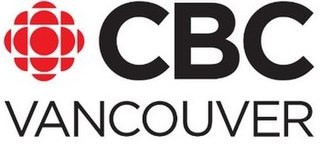A television broadcaster or television network is a telecommunications network for the distribution of television content, where a central operation provides programming to many television stations, pay television providers or, in the United States, multichannel video programming distributors. Until the mid-1980s, broadcast programming on television in most countries of the world was dominated by a small number of terrestrial networks. Many early television networks such as the BBC, CBC, PBS, PTV, NBC or ABC in the US and in Australia evolved from earlier radio networks.
The CTV Television Network, commonly known as CTV, is a Canadian English-language terrestrial television network. Launched in 1961 and acquired by BCE Inc. in 2000, CTV is Canada's largest privately owned television network and is now a division of the Bell Media subsidiary of BCE. It is Canada's largest privately or commercially owned network consisting of 22 owned-and-operated stations nationwide and two privately owned affiliates, and has consistently been placed as Canada's top-rated network in total viewers and in key demographics since 2002, after several years trailing the rival Global Television Network in key markets.

The Global Television Network is a Canadian English-language terrestrial television network. It is currently Canada's second most-watched private terrestrial television network after CTV, and has fifteen owned-and-operated stations throughout the country. Global is owned by Corus Entertainment — the media holdings of JR Shaw and other members of his family.
CJOH-DT is a television station in Ottawa, Ontario, Canada, serving the National Capital Region as part of the CTV Television Network. It is owned and operated by network parent Bell Media alongside Pembroke-licensed CTV 2 outlet CHRO-TV. The two stations share studios with Bell's Ottawa radio properties at the Market Media Mall building on George Street in downtown Ottawa's ByWard Market; CJOH-DT's transmitter is located on the Ryan Tower at Camp Fortune in Chelsea, Quebec, north of Gatineau.

CHCH-DT is an independent television station in Hamilton, Ontario, Canada. Owned by Channel Zero, the station maintains studios on Innovation Drive in the west end of Hamilton; prior to 2021, it was located near the corner of Jackson and Caroline streets in downtown Hamilton for nearly 65 years. The station has additional offices at the Marriott on the Falls in Niagara Falls, Ontario. Its old transmitter was located on First Road West in the former city of Stoney Creek; it was demolished in March 2024 and replaced with a new transmitter located on Highway 5 near Millgrove Side Road in Dundas, Ontario, which started transmitting in November 2023.
CHRO-TV is a television station licensed to Pembroke, Ontario, Canada, serving the capital city of Ottawa as part of the CTV 2 system. It is owned and operated by Bell Media alongside CTV outlet CJOH-DT. The two stations share studios with Bell's Ottawa radio properties at the Market Media Mall building on George Street in downtown Ottawa's ByWard Market; CHRO-TV's transmitter is located on TV Tower Road near Pembroke. The station operates a digital-only rebroadcaster in Ottawa, CHRO-DT-43, with transmitter in the city's Herbert Corners section.

CBUT-DT is a television station in Vancouver, British Columbia, Canada, serving as the West Coast flagship of CBC Television. It is part of a twinstick with Ici Radio-Canada Télé station CBUFT-DT. The two stations share studios at the CBC Regional Broadcast Centre on Hamilton Street in downtown Vancouver; CBUT-DT's transmitter is located atop Mount Seymour in the district municipality of North Vancouver.
CBET-DT is a CBC Television station in Windsor, Ontario, Canada. The station's studios are located on Riverside Drive West and Crawford Avenue in Downtown Windsor, and its transmitter is located near Concession Road 12 in Essex.
CBLT-DT is a television station in Toronto, Ontario, Canada, serving as the flagship station of the English-language service of CBC Television. It is part of a twinstick with Ici Radio-Canada Télé outlet CBLFT-DT. The two stations share studios at the Canadian Broadcasting Centre on Front Street West in downtown Toronto, which is also shared with national cable news channel CBC News Network and houses the studios for most of the CBC's news and entertainment programs. CBLT-DT's transmitter is located atop the CN Tower.

CHAN-DT, branded Global British Columbia or Global BC, is a television station in Vancouver, British Columbia, Canada, serving as the West Coast flagship of the Global Television Network. Owned and operated by network parent Corus Entertainment, the station has studios on Enterprise Street in the suburban city of Burnaby, which also houses Global's national news headquarters. Its transmitter is located atop Mount Seymour in the district municipality of North Vancouver.
CFCF-DT is an English-language television station in Montreal, Quebec, Canada, part of the CTV Television Network. It is owned and operated by network parent Bell Media alongside Noovo flagship CFJP-DT. The two stations share studios at the Bell Media building, at the intersection of Avenue Papineau and Boulevard René-Lévesque Est in downtown Montreal; CFCF-DT's transmitter is located atop Mount Royal.

CJNT-DT is a television station in Montreal, Quebec, Canada, part of the Citytv network. Owned and operated by network parent Rogers Sports & Media, the station maintains studios inside the Rogers Building at the corner of McGill College Avenue and Cathcart Street near the Place Ville Marie complex in downtown Montreal, and its transmitter is located at Mount Royal Park, near downtown Montreal.
CBC Television is a Canadian English-language broadcast television network owned by the Canadian Broadcasting Corporation, the national public broadcaster. The network began operations on September 6, 1952, with its main studios at the Canadian Broadcasting Centre in Toronto. Its French-language counterpart is Ici Radio-Canada Télé.
An independent station is a broadcast station, usually a television station, not affiliated with a larger broadcast network. As such, it only broadcasts syndicated programs it has purchased; brokered programming, for which a third party pays the station for airtime; and local programs that it produces itself.

News broadcasting is the medium of broadcasting various news events and other information via television, radio, or the internet in the field of broadcast journalism. The content is usually either produced locally in a radio studio or television studio newsroom, or by a broadcast network. A news broadcast may include material such as sports coverage, weather forecasts, traffic reports, political commentary, expert opinions, editorial content, and other material that the broadcaster feels is relevant to their audience. An individual news program is typically reported in a series of individual stories that are presented by one or more anchors. A frequent inclusion is live or recorded interviews by field reporters.

Television in Canada officially began with the sign-on of the nation's first television stations in Montreal and Toronto in 1952. As with most media in Canada, the television industry, and the television programming available in that country, are strongly influenced by media in the United States, perhaps to an extent not seen in any other major industrialized nation. As a result, the government institutes quotas for "Canadian content". Nonetheless, new content is often aimed at a broader North American audience, although the similarities may be less pronounced in the predominantly French-language province of Quebec.
In Canada, a television system is a group of television stations which share common ownership, branding and programming, but which for some reason does not satisfy the criteria necessary for it to be classified as a television network under Canadian law. As the term "television system" has no legal definition, and as most audiences and broadcasters usually refer to groups of stations with common branding and programming as "networks" regardless of their structure, the distinction between the two entities is often not entirely clear; indeed, the term is rarely discussed outside the Canadian broadcasting enthusiast community. In the latter regard, however, a group of Canadian stations is currently considered a "network" if it satisfies at least one of the following requirements:
A regional variation generally refers to times when a radio station or television station simultaneously broadcasts different programs, continuity or advertisements to different parts of its coverage area. This may be so as to provide programming specific to a particular region, such as local news, or may be so as to allow advertisements to be targeted to a particular area.
This is a list of media in Sault Ste. Marie, Ontario, Canada. For stations licensed to Sault Ste. Marie, Michigan, see that city's article.
The first incarnation of E!, also referred to as E! Entertainment Television, was a Canadian English language privately owned television system that existed from 2001 to 2009 under the ownership of Canwest. At its peak it consisted of eight local television stations located in Quebec, Ontario, Alberta and British Columbia, including five stations owned and operated (O&O) by Canwest and three affiliates owned by Jim Pattison Group.





